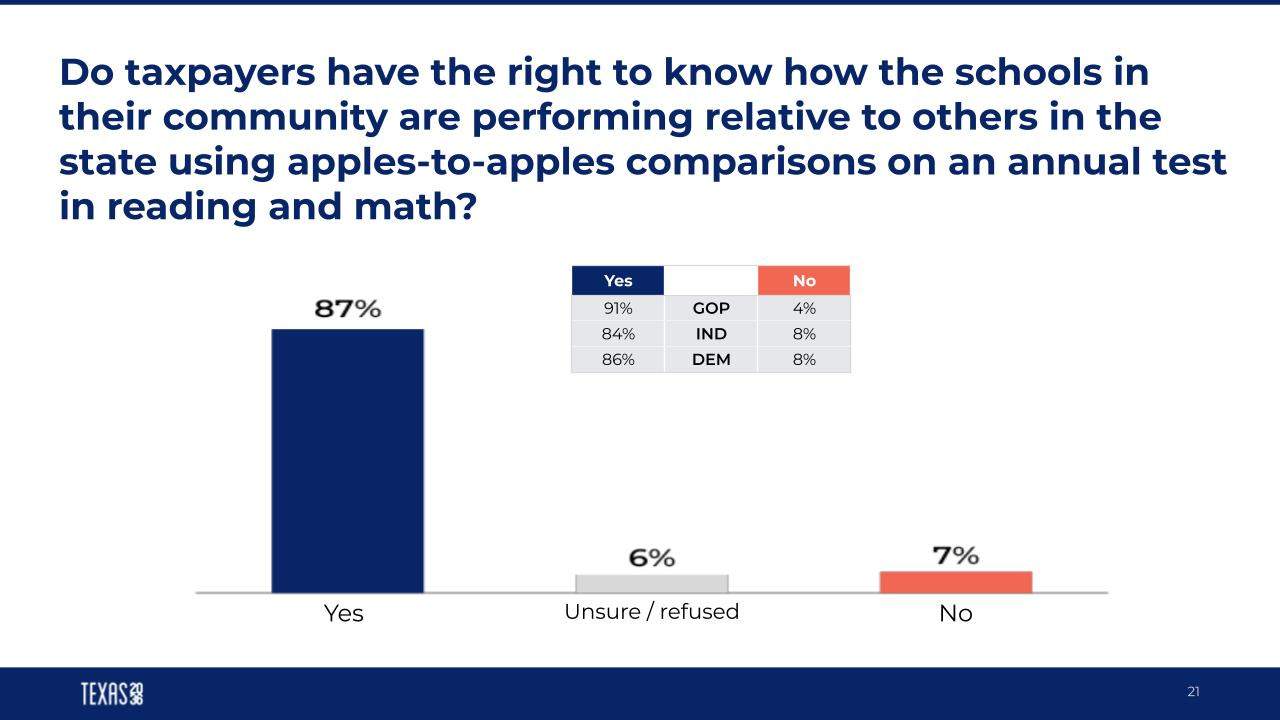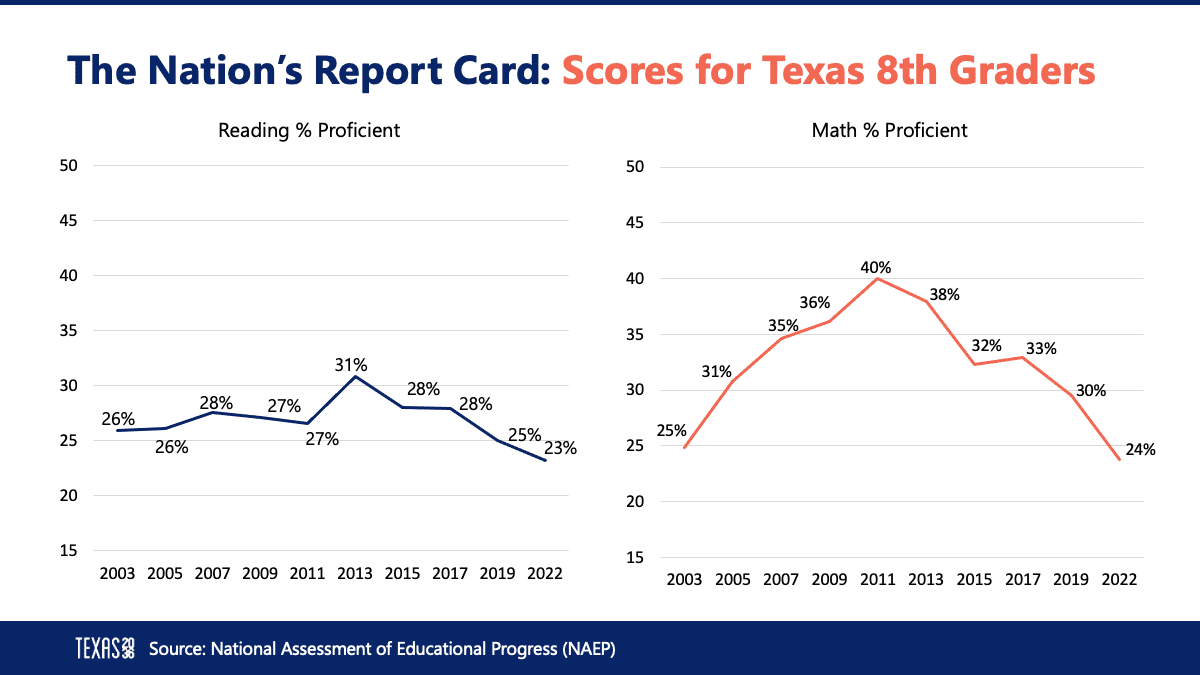TX2036 CEO Margaret Spellings delivers keynote to Texas Assessment Conference
The following remarks were delivered by Texas 2036 President and CEO Margaret Spellings during her keynote speech at Moak Casey’s Texas Assessment Conference on Nov. 8, 2022 in Round Rock, Texas.
It’s a great honor to speak before this prestigious audience of education and data experts. I have the privilege of leading Texas 2036, the nonpartisan, non-profit organization building long-term, data-driven strategies to help secure our state’s prosperity through our bicentennial and beyond.
I like to say that if we had a bumper sticker it would say that “we bring together the sensible center to think long term about the most important things using tons of data.” Admittedly a long bumper sticker.
One of our key differentiators at Texas 2036 is the hundreds of data sets we use to ground our policies. These form the backbone of our Strategic Framework for the state – likely the only long-term, comprehensive, statewide strategic assessment of its kind for Texas.
The Strategic Framework is where we measure and monitor progress across key policy areas and diagnose chronic conditions so that we can identify the best policy prescriptions for getting things moving in the right direction. And we make all of our data and analysis available to policymakers and the public.
Our work involves a holistic, systems approach to a spectrum of public policy areas across the whole of government including: education and workforce, health care, infrastructure, natural resources, justice and safety and government performance.
We take this approach because governing, like education, involves interworking and interrelated systems connected by cross-cutting, through line, themes. Like all things rural, or equity, or for children.
One theme that runs through all of our work is the opportunities and challenges presented by our rapid population growth. Texas added more than four million people between 2010 and 2020 and about 400,000 more just last year. Over the next 14 years, we can expect as many as 10 million more, bringing our population to about 40 million people. Rural Texas, at more than 3.04 million people, is larger than the total population of 18 other states and the District of Columbia.
Which leads us to the central question I am here to discuss.
Are we prepared to successfully equip millions of students and the generations who follow with the knowledge and skills to earn self-sustaining jobs, provide for their families, contribute to civic life, and enjoy the American and the Texas dream?
And the answer, my friends, is that the prognosis is not good unless we take decisive action to course correct. We don’t have time to waste!
There is strong civic demand for strengthening our education system – you read about it every day in the news. But what is less well reported is that there is also strong civic demand for gathering the data necessary to do so.
Education and workforce: What Texas voters agree on
In our latest Texas Voter Poll, which was conducted just a few weeks ago, 87% of Texas voters supported the use of annual reading and math tests to provide “apples-to-apples comparisons” of how local schools are performing relative to others in the state.

When you get beyond the marketing slogans and talking points, Texans understand that when it comes to ensuring our students are receiving a quality education, measurement matters.
Let’s set the stage with some historical context.
20 years ago, the U.S. transformed the way we approach education with the passage of the No Child Left Behind Act, for the first time requiring all schools to measure student progress annually in reading and math and take action to ensure that students receive a quality education.
And we called on states and districts to report results to the public and policy makers.
381 members of the U.S. House of Representatives voted for the bill, along with 87 U.S. Senators. These days that kind of bipartisanship is pretty rare, especially on something so consequential. It was a huge political achievement on a piece of legislation that affected every child in every county in our country. And it was possible because we came together and focused on what matters most – our students and their future.
No Child Left Behind meant that we were able to identify students that needed more help and target resources accordingly. It exposed nation-wide disparities in student performance and the substandard education black and brown children across the country were receiving, contributing to what President Bush called, “the soft bigotry of low expectations.” The results speak for themselves. Reading among eighth graders improved more in the first eight years after No Child Left Behind than for the nearly three decades that preceded the law.
We were able to accomplish this because we did three things: we measured outcomes, identified problems, and took action to address them. Wash. Rinse. Repeat. It’s a proven formula for success.But unfortunately, around the time of the financial crisis in 2008, we took our foot off the gas. And, again, the results speak for themselves.
Texas students have fallen behind their peers in other states on the fundamental building blocks of a good education – reading and math.
Texas students have fallen behind their peers in other states on the fundamental building blocks of a good education – reading and math. While Texas has the results from the STAAR test to draw conclusions on how students are learning, we can also look at our performance on the National Assessment of Educational Progress, known as NAEP. NAEP is a nation-wide assessment that compares states performance in core subjects.
The Nation’s Report Card: A look at Texas’ scores

Based on the NAEP scores released by the Department of Education two weeks ago, Texas improved in the national rankings. But this isn’t because Texas is doing better than we were before the pandemic, it is because those other states are now doing even worse than we are. Overall the data showed that we are at the lowest performance levels since the early 2000s in both 8th grade reading and math.
In fact, despite all the celebrations about STARR results being better this year, the sad reality is that nearly 60% of 3rd graders didn’t meet grade-level standards in math and 70% didn’t meet grade-level standards in reading. For 8th graders the numbers are even worse, with the lowest scores in math and reading in almost 20 years.
For low-income and minority students, the situation is dire.
Those students are too often stuck in failing schools without access to good teachers, rigorous curriculum, or the type of support they need to thrive. For example, at one Austin middle school, ONLY three percent of students perform in math at grade level with seven percent on grade level in science.
Across Texas, 60 percent of students – about three million students – are from economically disadvantaged homes and only one third are at grade level in reading and about a quarter at grade level in math. These outcomes should be unacceptable to all of us.
These dramatic disparities highlight the need for a robust diagnostic system that includes assessment and accountability to help ensure our schools get students on track for success – or at least on grade level.
So, it’s concerning when some groups and some legislators are fighting to reduce standards and eliminate the measurements that allow us to see where our kids are, especially since the pandemic.
Of course, there’s one group of people unwilling to pretend there’s no problem, and that’s parents. Those who run from measurement and transparency are laying the groundwork for private school vouchers and a ‘vote with your feet’ accountability system.
We must tell the truth about student achievement, even when results are disappointing, and hold ourselves accountable for results.
Education in Texas is a $70 billion enterprise that supports a $2 trillion state economy. It’s unworkable for everyone to pick and choose what they’re measured on. It obfuscates and muddies the picture. We need standards across the state. Unfortunately, this is a phenomenon on both sides of the aisle and sadly has created a threat to generations of students.
The talking points being used to advocate for watering down accountability and assessment and disconnecting performance from the valid data we collect amount to a mirage. They would create a school system without the information to improve the enterprise and resource its challenges effectively. If Texas standards are already low and our student outcomes are declining, what will lowering expectations even further do to our students’ and our state’s economic future?
Educational assessments: Why they matter
If Texas standards are already low and our student outcomes are declining, what will lowering expectations even further do to our students’ and our state’s economic future?
Again, history bears this out. In the 1990s and early 2000s, Texas led the nation in implementing rigorous standardized assessment and accountability, which resulted in Texas charting a path towards better outcomes. At that time, the statewide math scores grew by 14 percent within six years.
That’s why in 2019, the Texas legislature worked to address the slide in school performance by passing House Bill 3, a sweeping and historic school finance bill, which provided more money for Texas classrooms and increases in teacher pay. Unfortunately, the pandemic has slowed progress, but the data-driven system it created and resourced – if left intact – has tremendous potential to improve our schools.
This is not the time to back away from reforms that generated widespread bipartisan support and that put our money where our mouths are. Nor is it time to back away from the test that these reforms are built on. Despite what many believe, the STAAR test is reviewed by Texas teachers, endorsed by psychometricians and other experts, and aligned with other measures like the National Assessment of Educational Progress.
Thanks to Education Commissioner Mike Morath, the STAAR test has also recently undergone significant improvements to better align it to the classroom experience and allow for it to be administered online to get information to students, parents and teachers more quickly.
But simply measuring is not enough.

A checklist of a good assessment system includes high standards; measurement systems that are valid, reliable and comparable; exemption rates that are not excessive; and timely, disaggregated data. And then using the data as a yardstick to show how schools are performing, not just relative to each other, but to a standard of quality and readiness.
This data also provides critical feedback for lawmakers and other state leaders as they look to align resources with the needs of students.
That’s where we at Texas 2036 come in.
We collect and analyze data, and look carefully at warning signs. We also monitor and analyze outcomes from the latest efforts to address COVID-related loss. We then make recommendations to state leaders so that they can address problem areas.
In other words, we follow that same formula for success I spoke of earlier: we measure outcomes, identify problems, and help take action to address them. Some of you may recall a quote by former President Trump about COVID testing: “If we stop testing, we’d have fewer cases.” This strategy didn’t make sense for COVID, and it doesn’t make sense for students. Without assessments, we would not know what our specific problems are. And without knowing what the problems are, we have no way of knowing how to address them.
Without assessments, we would not know what our specific problems are. And without knowing what the problems are, we have no way of knowing how to address them.
The stakes are high. If Texas fails to address students’ COVID learning loss, one study predicts our state will lose more than $1 trillion in economic activity over these students’ lifetimes.
Student achievement: Improving it through assessment
When the Texas Legislature convenes in January for the 88th legislative session, education is going to be top of mind for many. In fact, our Texas Voter Poll showed that Texans placed public education as their top spending priority for the state’s budget surplus. Lawmakers will be making decisions with far-reaching implications for our schools and students. Without assessments, our policy makers lack the data necessary to act. But armed with data, we can implement and resource measures that can improve student outcomes, like addressing the quality of our curricular materials.
Commissioner Morath has spoken about the importance of “increasing the rigor of the content students learn.” I agree. Besides the teacher in the classroom, a critical aspect is the quality of our instructional materials. This means more materials with research-based track records of improving student outcomes for all learners, so we, and they, don’t waste valuable time.
We must raise our expectations for our teachers, our students and ourselves. We need more rigor through advanced coursework, like AP, IB and dual-enrollment programs. And we need to be innovative about ensuring these opportunities are available to all Texas students regardless of their income or location by closing the digital divide and leveraging new technologies.
With available federal funds and legislative budget commitments, we HAVE the resources and the expertise to meet the moment. All we need is the willingness and expectation to come together as parents, teachers, advocates, and policymakers.
So how are we at Texas 2036 building the political will and expectations to move our state forward?
During the last legislative session, our education policy agenda was laser focused on addressing COVID-related learning loss, and we pursued a variety of solutions guided by the following principles:
- Assessment and accountability ensure equity;
- Proven practices benefit students; and
- Education funding should be stable and prioritized.
We sought to protect investments in evidence-based education reforms and maintain appropriate student assessment and accountability. And we supported leveraging federal stimulus funds to address existing long-term achievement gaps and learning loss.
We supported efforts to improve online and digital learning, which provide an important opportunity for students in rural and low-income schools, particularly for advanced coursework like Algebra I for 8th grade and greater access to AP courses.
The combined goal of these efforts is to ensure ALL Texas students have an education that equips them for a lifetime of success.
Looking ahead to next year’s legislative session, our team remains committed to developing data-driven policies that improve student learning and outcomes. We will support the development and adoption of high-quality curriculum, and build on the crucial investments in House Bill 3.
And we will encourage state leaders to take action to improve teacher quality, compensation and training. And to increase access to high-quality tutoring as well as virtual learning and other innovative education models.

The combined goal of these efforts is to ensure ALL Texas students have an education that equips them for a lifetime of success. But we can’t accomplish this alone. The work you are doing – the very fact that you are here today at this conference – is critical to the future success not only of our students, but of our state.
Historically, Texas has grown its economy thanks in large part to domestic and international migration, with well-educated people moving to our state to fill jobs and create a better life. But migration patterns are volatile. They slow periodically and cannot be relied on to meet our state’s future needs.
Texas educational accountability: Why it matters
Most importantly, though, we simply cannot write-off our Texas students, relegating them to second-class status in their own home state.
And, yet, that is in some ways what we are doing today.
Despite spending more than $100 billion per year on education and workforce programs, an unsustainable skills gap is growing. 90 percent of Texas students graduate high school, but only 58 percent seek a post-secondary degree or credential and only 26 percent ultimately earn a credential within six years of graduating. But over the next 14 years, we know that more than 70 percent of jobs in Texas will require post high school credentials.
We are also facing a gender gap in educational attainment. The educational achievement of men in this country – and across the globe – has plateaued, with women increasingly more likely to attend college.
In the U.S., 60% of students on college campuses are women compared to 40% of men—a difference that continues to grow. Here in Texas, degree and certificate completion by women rose by 7% between 2019 and 2021, while for men it fell by 2½%.
We cannot perpetuate an educational system that leaves our young men behind. If the system isn’t working for them, we must think more about creating the kind of system that will.
To get to where we want to be as a state will not be easy in this political environment. That’s why I started with our bumper sticker mission about bringing together the sensible center to think long term about the most important things using tons of data.
I encourage everyone here to connect with us, introduce yourselves, add your name to our email lists, join one of our education policy advisory groups or attend a future event on educational assessment.
Thank you.
